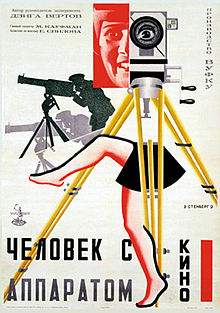 The Man With The Movie Camera was produced in 1928 by Dziga Vertov. Vertov was employed by the MoscowState film studio’s until his films, which were often political manifesto’s about the nature and possibilities of film, fell out of favor with Stalinist Russia. Only under Kruschev in the early 60’s did his films re-emerge.One of Vertov’s tasks was to cultivate a new cinematic language and thus rejecting traditional cinema, particularly Western narrative cinema that drew heavily upon literature and staged acting. He wanted to show the beauty of the actual without the artificiality of stages and actors which function on the presupposition of filmed reality. Vertov attempted to film life as it was or life caught unaware because people act differently on camera than when not in front of the eye. Often considered a formalist, Vertov emphasized the artistic process of filmmaking itself through editing, special effects, camera angle and position in order to capture reality but also suggest an ideal reality. Viewing THWTMC provides an excellent opportunity to gain visual literacy. Vertov utilized the montage, or “two film pieces of any kind, placed together, inevitably combine into a new concept, a new quality, arising out of that juxtaposition.” Vertov is a master at this. Not only as viewers are we forced to contend with the composition and structure of each shot, we must interpret the purposeful sequences of images that may build upon, interpret, or juxtapose past or future images. Vertov is working on a great number of conceptual ideas in this film.We would do well to keep our eyes out for a few key ideas. The film, in one sense, is a statement about film…what it should be and what it should not be. Vertov’s a film is both art and art theory. THWTMC attempts to show an interconnectedness between humanity and machine. Vertov shows the joys of work, the similarity of rhythms between humanity and the city. The city, the machines, and humanity are merged into one larger machine. It is a celebration of the Soviet workers state. Vertov is also attempting to show the that the filmmaker is a key part in this workers world performing similar duties to factory workers that were needed to keep this larger national machine running. Vertov works symbolically through special effects and editing.Watch for the juxtaposition of shots and what they symbolize. Vertov was intrigued with Einstein’s theory of relativity and thus tries to show the relativity of time, space, size, etc. 1) How did Vertov convey the interconnectedness of the city and humanity? 2) How did Vertov show the importance of his own role in society? 3) Which editing sequences did you find most interesting? 4) Do you see this as a narrative piece or non-narrative documentary style film? 5) What similarities does Vertov’s film share with Reggio’s Koyaanisqatsi? 6) What are the two filmmakers perspectives on technology? 7) What relevance does Vertov’s work have for us today? View The Man With the Movie Camera online. Another fascinating site is www.dziga.perrybard.net/, an updating ofTMWTMC. By inviting others to contribute similar scenes from their own video collections, the film is recreated and run along side of each other.
0 Comments
Your comment will be posted after it is approved.
Leave a Reply. |
Ryan StanderArchives
January 2018
Categories
All
|

 RSS Feed
RSS Feed
